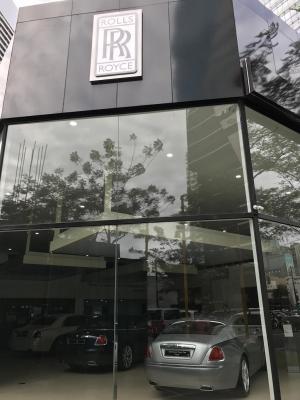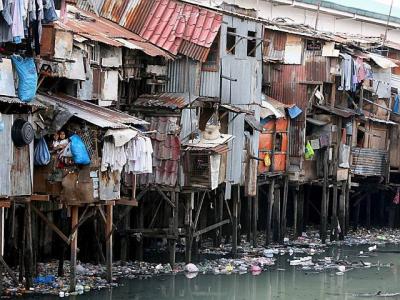We love Manila because they don’t charge us for plastic bags at the grocery.
Just kidding. Well, maybe not really. “Love” of a city is a complex thing. People ask us all the time about our favorite places, and without thinking we typically respond, “Spain, Portugal, the Oregon coast, Paris, and Des Moines”. And maybe a few other favorite spots. Asian megacity Manila, capital of the Philippines, may never earn a ranking in our ad hoc list of favorite destinations in the world, but we can say we’ve been here, and it IS likely that we will return. And to be honest, we’ve never been to Des Moines, but we hear it might be nice two or three days of the year.
The Philippines is a collection of over 7,600 islands in the western Pacific. Spanish conquistadors arrived in the 1570’s, weary from their first transpacific crossing wearing big shiny bronze hats and shiny bronze breastplates over woolen tunics. They must have thought they were headed somewhere cold, and they must have been doubly surprised to find themselves amongst broadly smiling natives, comfortable in their cargo shorts and flip flops. The Spanish came to convert them to Christianity—and in search of gold, cerveza, and burritos (in that order)—and were prepared to kill them in order to show them just how much God loved them. Surprisingly (or maybe not so), the queen was amenable and converted; her people quickly followed suit.
While the Spanish didn’t find the gold they were constantly in search of, they did find a strategic spot to connect their American colonies to Asia, and the first trade route across the Pacific ocean was open for business. The indigenous Filipinos and the Spanish got along famously for the next 300 years, intermingling their genes as humans tend to do, and the Spanish influence on Filipino culture, from the architecture of Manila’s Intramuros old town to the local cuisine, is unmistakable. Even the name, “Philippines”, refers to Spain’s King Philip II (1554-1558).
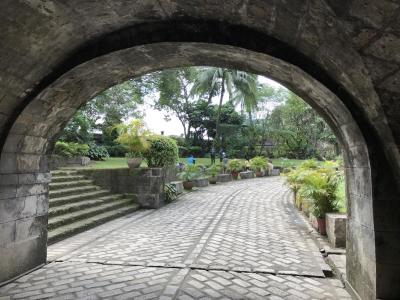
Part of the Spanish Intramurous Old Town, Manila
But by the end of the 19th century, Spanish influence around the world was waning and another colonial power was growing. The Spanish-American war unseated Spain’s global prominence and America was flexing post-Civil War muscle. When the American army’s 10,000 well-trained and well-equipped troops, allied with 30,000 Filipinos anxious for independence, knocked on the door of the Spanish garrison in Manila, the Spanish said, “Oh, ok, you can have the Philippines”. The Philippines then became an American possession.
The problem was, the Americans had promised the Filipinos independence in exchange for their support against the Spanish. At the time, America was trying to behave like the European superpowers had been behaving the previous three centuries and build her own global empire. Needless to say, the Filipinos were none too happy.
Now comes a bit of American history that this American only recently learned about. How many of my fellow Americans have heard of the Philippine-American War? America lost as many as 6,100 in this forgotten war, twice as many as was killed in the Spanish-American war just a few years earlier. Why is it that this episode of American history hardly rates a footnote in American history texts? Could it be because of our reneged promise to the Filipino people?
American 19th century imperialism notwithstanding, the Philippines grew and prospered under benevolent governance for more than four decades. Filipinos recognize the benefits of the education system installed by the Americans, even to today. But in 1942, not caring so much for having an American military presence so close to the homeland, the Japanese came bearing samurai swords and an apparent grudge. Facing overwhelming numbers, American General Douglas McArthur abandoned the Philippines, famously promising that “he’d be back,” as he angrily threw his corncob pipe in the general direction of the Japanese forces.

Bombed-Out Ruins from WWII’s Battle of Manila
I will skip over the part about Japanese imperial forces doing very bad terrible things, like the whole Bataan Death March episode and the countless Filipinos that were slaughtered under Japanese rule. Let’s just all agree that they weren’t very nice.
Unlike previous Americans, McArthur lived up to his promise and returned in late 1944. The battle to liberate Manila left over 1,000 Americans, 5,500 Filipinos, and nearly 17,000 Japanese dead. An estimated 100,000 Filipino civilians died. Manila was reduced to rubble. Shortly after the war ended, the Americans finally lived up to their original promise and granted the Philippines their independence on (with a touch of symbolism or irony, depending on your viewpoint) the 4th of July, 1946.
Today, metro Manila’s almost 15 million inhabitants make it the seventh largest city in the world. They are a unique blend of Spanish, American, and Asian cultures, a proud and sometimes defiant people, as evidenced when President Aquino asked the American military to leave in the 1980’s and very recently with popular president Duterte thumbing his nose and flicking verbal boogers at the United States.

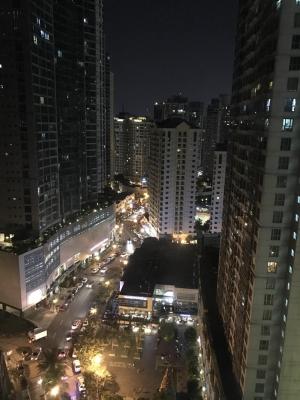
Top: Our Highrise AirBnB Building in Manila. Bottom: Our View At Night.
A friend asked us back in the fall, “Are you sure you want to go to the Philippines? Haven’t you heard about their President?” If you weren’t aware, Filipino President Rodrigo Duterte has called President Barack Obama some unflattering things recently (paraphrased, he called President Obama the offspring of a prostitute). Duterte was elected on a hardline platform to, in part, crack down on crime in the Philippines, a problem on par with recent history in Mexico. Duterte’s war on violent crime, and America’s beef with Duterte, centers around a so-called “death list” of people, alleged criminals that Filipino police forces are authorized to kill on the spot. Death warrants having long been out of judicial fashion in the United States, our State Department expressed their concern. And Duterte hurled his insults.
I’ll only say this (especially while I’m still in the Philippines, a guest of the quite handsome and rather manly President Duterte): the Filipinos support their president (from what we’ve seen and heard). He was democratically elected, and the problems he was elected to fix are of very serious concern to his people.
So why did we come here? In short, business brought us here. And business brings a lot of people here. The corner of Manila where we’re staying is called Bonifacio Global City, or simply BGC. It is the site of a former American military installation (intersected by McKinley Parkway, named after the US President), and now the home of dozens (literally) of skyscrapers packed with employees of Oracle, American Express, Microsoft, Sun Life Financial, Zendesk, and many others. For two years I’ve been working with a few very talented Filipino programmers and it was time to meet them. From here, Manila is a jumping off point to likely more interesting parts of the Philippines and Asia.
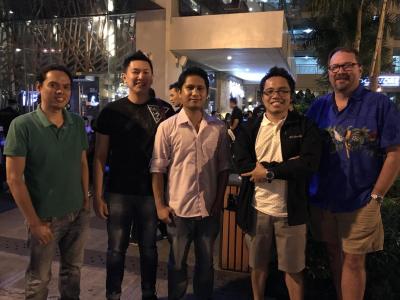
My Team In The Philippines
Perhaps because of the presence of all these American companies, this part of Manila feels as American to us as New York or San Francisco (and–as an added bonus!–with almost as many Asian people). The stores are filled with American brands, and American restaurant chains are everywhere (like the McDonald’s across the street from us). English is not just prevalent, it’s everywhere: from the traffic signs to menus to bathroom placards. And Filipinos love their American-style shopping malls, filled with store brands like Columbia Sportswear, DC, Speedo, The North Face, New Balance, Forever 21, GNC, American Eagle Outfitters, Estee Lauder, Crate & Barrel, Starbucks (naturally), and more.
Manila does have a handful of sites for visitors, including the Spanish-era Intramuros, the old town near the center of the metropolis and along the Pasig River where it flows into Manila Bay and the South China Sea. There’s the spectacular San Augustin church and even more splendid attached museum (where eager guides personally show you around—we had a tour guide to ourselves). Just down the street is the cathedral of Manila, rebuilt after the devastation of WWII, and another block further is the 400 year-old Spanish Fort Santiago. One day before we leave Manila we plan to head south into the countryside (the “provinces”, as Filipinos say) and see some natural beauty at Tagaytay and the Taal Volcano.
Manila might also be a developing healthcare destination. On our first day here, I placed an order for prescription sunglasses, progressive bifocals no less. The exam and the glasses cost me $300 total, just a little over half of what I would have paid at Walmart back home. And a few days ago, Lori filled a prescription sufficient to last our entire jaunt around the world simply by showing her American prescription—no questions asked on the number of pills she requested, quite unlike back home—and we walked away paying about 30% less than our copay back home. Need I point out that this was without the “benefit” of a health insurance plan?

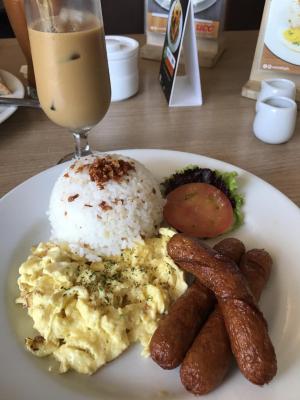
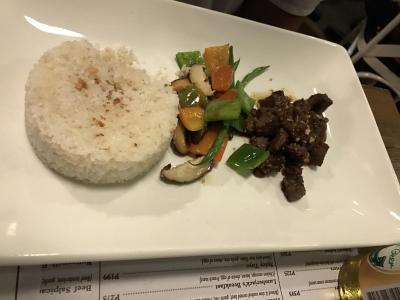
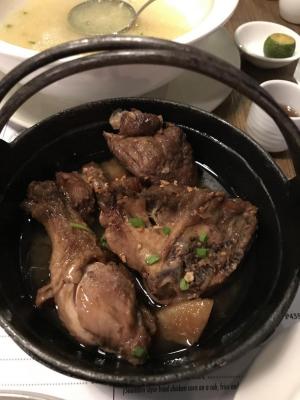
From Top: Grilled Fish Skewers; Breakfast; Beef Salpaico; Chicken and Pork Adobo, “CPA”
Cuisine is an unsurprising blend of Spanish and American influences, ranging from burritos to fried chicken. Traditional breakfasts, including at McDonald’s, are served with rice. But the crowning achievement of native Filipino cuisine seems to be the surprisingly excellent local beer, San Miguel. It’s an American style lager available in regular and light, and apple and lemon flavors. And in some places you can ask for salted caramel beer, a genuine treat.
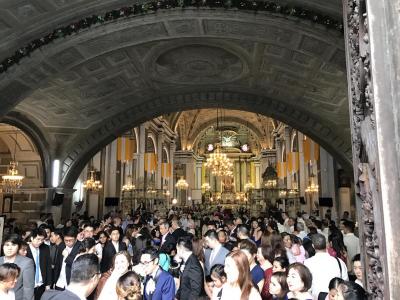
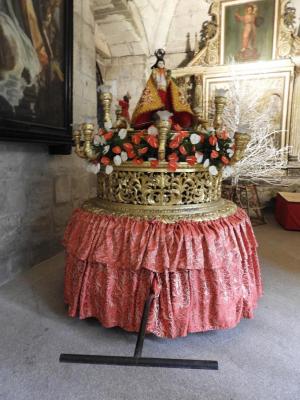
Top: Filipinos Leaving Church. Bottom: Los Niños de Cebu, Prepared To Lead A Processing Through Manila
What’s truly great about Manila is the Philippine people. Filipinos are friendly, polite, and embarrassingly eager to be hospitable. Even today, after their challenging history, they greet visitors with wonderful, broad smiles, just like they greeted the Spanish conquistadors. Of whether their genetics predisposes them to perpetual cheerfulness or merely the appearance of the same, I’ll reserve my opinion.
Still, Manila is a city of economic contrasts. The gap from rich to poor is staggering, perhaps mirrorring the global gap from the richest of the richest to the poorest of the poor. Blocks from where we are staying is a Rolls Royce dealer. A few miles further are slums. It might never be one of our favorite places, but for a number of reasons we are certain to return.
